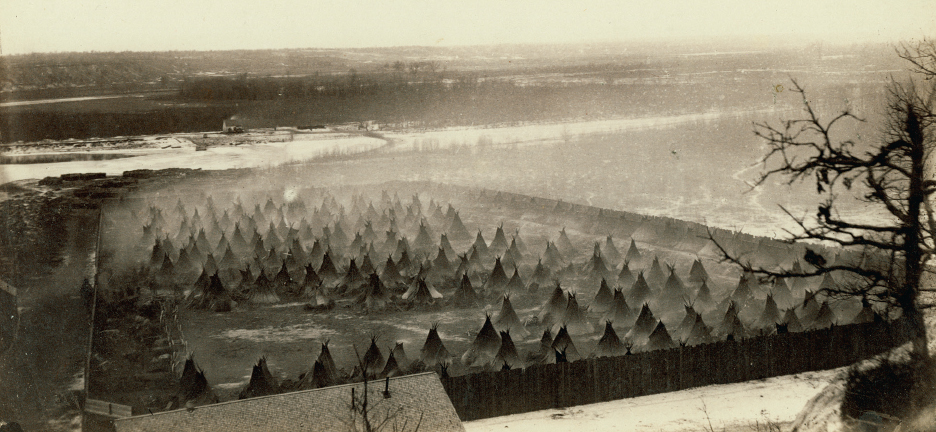The Civil War and Indians on the Plains
In August 1862, the attention of most Unionists and Confederates was riveted on General George McClellan’s failing campaign in Virginia. But in Minnesota, the Dakota Sioux were increasingly frustrated. In 1858, the year Minnesota secured statehood, they had agreed to settle on a strip of land reserved by the government, in exchange for receiving regular payments and supplies. But Indian agents, contractors, and even Minnesota’s territorial governor pocketed most of the funds. When the Dakotas protested that their children were starving, state officials dismissed their appeals. Corruption was so egregious that one leading Minnesotan, Episcopal bishop Henry Whipple, wrote an urgent appeal to President James Buchanan. “A nation which sows robbery,” he warned, “will reap a harvest of blood.”
Whipple’s prediction proved correct. During the summer of 1862, a decade of anger boiled over. In a surprise attack, Dakota fighters fanned out through the Minnesota countryside, killing immigrants and burning farms. They planned to sweep eastward to St. Paul but were stopped at Fort Ridgely. In the end, more than four hundred whites lay dead, including women and children from farms and small towns. Thousands fled; panicked officials telegraphed for aid, spreading hysteria from Wisconsin to Colorado.

Minnesotans’ ferocious response to the uprising set the stage for further conflict. A hastily appointed military court, bent on revenge, sentenced 307 Dakotas to death, making it clear that rebellious Indians would be treated as criminals rather than warriors. President Abraham Lincoln reviewed the trial records and commuted most of the sentences but authorized the deaths of 38 Dakota men. They were hanged just after Christmas 1862 in the largest mass execution in U.S. history. Two months later, Congress canceled all treaties with the Dakotas, revoked their annuities, and expelled them from Minnesota. The scattered bands fled west to join nonreservation allies.
As the uprising showed, the Civil War created two dangerous conditions in the West, compounding the problems already caused by corruption. With the Union army fighting the Confederacy, western whites felt vulnerable to Indian attacks. They also discovered they could fight Indians with minimal federal oversight. In the wake of the Dakota uprising, worried Coloradans favored a military campaign against the Cheyennes — allies of the Sioux — even though the Cheyennes had shown little evidence of hostility. Colorado militia leader John M. Chivington, an aspiring politician, determined to quell public anxiety and make his career.
In May 1864, Cheyenne chief Black Kettle, fearing his band would be attacked, consulted with U.S. agents, who instructed him to settle along Sand Creek in eastern Colorado until a treaty could be signed. On November 29, 1864, Chivington’s Colorado militia attacked the camp while most of the men were out hunting, slaughtering more than a hundred women and children. “I killed all I could,” one officer testified later. “I think and earnestly believe the Indian to be an obstacle to civilization and should be exterminated.” Captain Silas Soule, who served under Chivington but refused to give his men the order to fire, dissented. “It was hard to see little children on their knees,” he wrote later, “having their brains beat out by men professing to be civilized.” Chivington’s men rode back for a celebration in Denver, where they hung Cheyenne scalps (and women’s genitals) from the rafters of the Apollo Theater.
The northern plains exploded in conflict. Infuriated by the Sand Creek massacre, Cheyennes carried war pipes to the Arapahos and Sioux, who attacked and burned white settlements along the South Platte River. Ordered to subdue these peoples, the U.S. Army failed miserably: officers could not even locate the enemy, who traveled rapidly in small bands and knew the country well. A further shock occurred in December 1866 when 1,500 Sioux warriors executed a perfect ambush, luring Captain William Fetterman and 80 soldiers from a Wyoming fort and wiping them out. With the Fetterman massacre, the Sioux succeeded in closing the Bozeman Trail, a private road under army protection that had served as the main route into Montana.
General William Tecumseh Sherman, now commanding the army in the West, swore to defeat defiant Indians. But the Union hero met his match on the plains. Another year of fighting proved expensive and inconclusive. In 1868, the Sioux, led by the Oglala band under Chief Red Cloud, told a peace commission they would not sign any treaty unless the United States pledged to abandon all its forts along the Bozeman Trail. The commission agreed. Red Cloud had won.
In the wake of these events, eastern public opinion turned against the Indian wars, which seemed at best ineffective, at worst brutal. Congress held hearings on the slaughter at Sand Creek. Though Chivington, now a civilian, was never prosecuted, the massacre became an infamous example of western vigilantism. By the time Ulysses Grant entered the White House in 1869, the authors of Reconstruction in the South also began to seek solutions to what they called the “Indian problem.”
IDENTIFY CAUSES